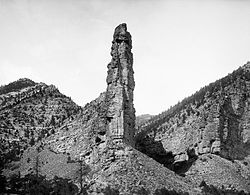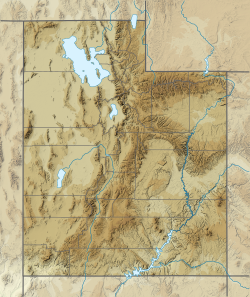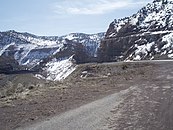Castle Gate, Utah
Castle Gate | |
|---|---|
 Castle Gate spires, near old townsite | |
Location in the United States Location in Utah | |
| Coordinates: 39°43′40″N 110°52′03″W / 39.72778°N 110.86750°W | |
| Country | United States |
| State | Utah |
| County | Carbon |
| Founded | 1886 |
| Abandoned | 1974 |
| Named for | Rock formation resembling the gate of a castle |
| Elevation | 6,152 ft (1,875 m) |
| GNIS feature ID | 1426382[1] |
Castle Gate is a ghost town in the western United States, located in Carbon County in eastern Utah. A mining town approximately ninety miles (140 km) southeast of Salt Lake City, its name was derived from a rock formation near the mouth of Price Canyon. This formation features two sheer sandstone walls on either side of the Price River, which appear to open like a giant gate as travelers approach this narrow section of the canyon.
Coal mining origins
[edit]The first coal mine, named the Castle Gate Mine #1, opened around 1886, after the Denver and Rio Grande Western Railroad constructed its Utah Division over the Wasatch Plateau, from the town of Springville.[2] The mine produced high-quality coal for the steam trains. Castle Gate Mine #2 opened in 1912, and was found to have the finest coal in the region. In 1914, Castle Gate was incorporated as a town, which was owned and tightly controlled by the Utah Fuel Company and the D&RGW; a third mine opened in 1922.[citation needed]
Historic events
[edit]The town is most famous for two historic events. On April 21, 1897, Butch Cassidy and Elzy Lay held up an employee of the Pleasant Valley Coal Company in a daylight robbery at the busy railroad station in Castle Gate, making off with $7,000 in gold.[citation needed]
On March 8, 1924, the Utah Fuel Company's Castle Gate Mine #2 exploded, killing 172 miners. Fatalities included 49 Greeks, 22 Italians, 8 Japanese, 7 English, 6 Austrians (Yugoslavs), 2 Scots, 1 Belgian, and 76 Americans, including 2 African-Americans.[2] It was the third-deadliest disaster in the history of coal mining in the United States at that time, and remains the tenth deadliest at present.[citation needed]
Deconstruction of the town
[edit]Castle Gate was dismantled in the summer of 1974,[3] and residents were relocated to a new subdivision at the mouth of Spring Canyon, west of Helper. The former townsite was cleared and replaced with coal-loading facilities neighboring the railroad line.
-
Castle Gate, with the former townsite to the left
-
Denver and Rio Grande Western Railroad locomotive at Castle Gate (circa 1929)
See also
[edit]References
[edit]- ^ a b U.S. Geological Survey Geographic Names Information System: Castle Gate
- ^ a b "Utah History Encyclopedia". www.uen.org. Retrieved March 8, 2021.
- ^ "Requiem for a dying town". Lewiston Morning Tribune. (Idaho). Associated Press. August 12, 1974. p. 14.
External links
[edit]- "Utah Fuels The West, Castle Gate Mines". utahrails.net.





